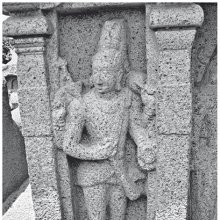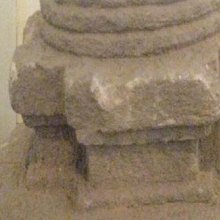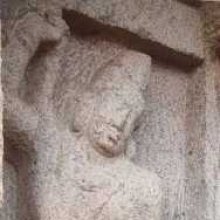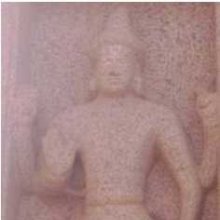Ratha: 32 definitions
Introduction:
Ratha means something in Buddhism, Pali, Hinduism, Sanskrit, Jainism, Prakrit, the history of ancient India, Marathi, Hindi, biology. If you want to know the exact meaning, history, etymology or English translation of this term then check out the descriptions on this page. Add your comment or reference to a book if you want to contribute to this summary article.
Images (photo gallery)
(+40 more images available)
In Hinduism
Vaishnavism (Vaishava dharma)
Source: ISKCON Press: GlossaryRatha (रथ).—Temple cart or chariot, used during religious festival to carry the Deities.

Vaishnava (वैष्णव, vaiṣṇava) or vaishnavism (vaiṣṇavism) represents a tradition of Hinduism worshipping Vishnu as the supreme Lord. Similar to the Shaktism and Shaivism traditions, Vaishnavism also developed as an individual movement, famous for its exposition of the dashavatara (‘ten avatars of Vishnu’).
Purana and Itihasa (epic history)
Source: archive.org: Shiva Purana - English Translation1) Ratha (रथ) refers to “chariots”, according to the Śivapurāṇa 2.3.15 (“The penance and reign of Tārakāsura”).—Accordingly, as Brahmā narrated: “[...] At the same time, several phenomena of evil portent forboding misery and distress happened, when the son of Varāṅgī was born making the gods miserable. [...] O great Brahmin, the misty haloes around the sun and the moon in the grip of Rāhu became the harbingers of great fear and unhappiness. At that time terrifying sounds that resembled those of the chariot [i.e., ratha-nirhrāda-tulya] issued forth from cracks and crevices in the mountains. [...]”.
2) Ratha (रथ) refers to the “(divine) chariot (of lord Śiva)” (built by Viśvakarman), according to the Śivapurāṇa 2.5.8 (“The detailed description of the chariot etc.”).—Accordingly, as Sanatkumāra narrated to Vyāsa: “The divine chariot (ratha) of lord Śiva consisting of all the worlds was built by Viśvakarman with devoted effort. [sarvalokamayo divyo ratho yatnena sādaram] It was appreciated by all. It was golden in colour and all the elements had gone into its making. The right wheel was the sun and the left wheel was the moon. [...]”.
Source: Cologne Digital Sanskrit Dictionaries: The Purana IndexRatha (रथ).—Of the moon, description of; sprang out of waters with ten horses, charioteer, etc., has three wheels.*
- * Vāyu-purāṇa 52. 50-4.

The Purana (पुराण, purāṇas) refers to Sanskrit literature preserving ancient India’s vast cultural history, including historical legends, religious ceremonies, various arts and sciences. The eighteen mahapuranas total over 400,000 shlokas (metrical couplets) and date to at least several centuries BCE.
Vyakarana (Sanskrit grammar)
Source: Wikisource: A dictionary of Sanskrit grammarRatha (रथ).—Name of one of the eight kinds of recitals of the Veda Samhita by dividing it into the component words (पद (pada)) and reciting the component words by repeating them, in their regular order and reverse order too.

Vyakarana (व्याकरण, vyākaraṇa) refers to Sanskrit grammar and represents one of the six additional sciences (vedanga) to be studied along with the Vedas. Vyakarana concerns itself with the rules of Sanskrit grammar and linguistic analysis in order to establish the correct context of words and sentences.
Jyotisha (astronomy and astrology)
Source: Wisdom Library: Brihat Samhita by Varahamihira1) Ratha (रथ) refers to the “chariot [i.e., that which carries ?]” (of the sun), according to the Bṛhatsaṃhitā (chapter 12), an encyclopedic Sanskrit work written by Varāhamihira mainly focusing on the science of ancient Indian astronomy astronomy (Jyotiṣa).—Accordingly, “Hear now the effects of the heliacal rising of Canopus (Agastya), a star sacred to Agastya who suppressed the Vindhya mountains whose soaring heights obstructed the course of the Sun [i.e., dinakara-ratha-mārga-vicchitti]; to which the pictured robes of the Vidyādhara females leaning for support on their lord’s arms and flying aloft in the sky formed beautiful flowing flags; whose caves were the abodes of lions which, having drunk of the perfumed blood of elephants in rut had their mouths covered with bees that looked like so many black flowers, and from which caves issued rivers; [...]”.
2) Ratha (रथ) is the name of a River identified with Guṇḍaka (according to Kāśyapa), according to the Bṛhatsaṃhitā (chapter 16) (“On the planets—graha-bhaktiyoga”), an encyclopedic Sanskrit work written by Varāhamihira mainly focusing on the science of ancient Indian astronomy astronomy (Jyotiṣa).—Accordingly, “Mercury presides over the western half of the Lohitya river, the Indus, the Sarayū, the Gāmbhīrika, the Ratha, the Ganges and its tributary the Kauśi. He also presides over the countries of Videha, Kāmboja; the eastern half of Mathurā, the Himālayas, the Gomanta, the Citrakūṭa mountains, Saurāṣṭra; people living on table lands, [...]”.

Jyotisha (ज्योतिष, jyotiṣa or jyotish) refers to ‘astronomy’ or “Vedic astrology” and represents the fifth of the six Vedangas (additional sciences to be studied along with the Vedas). Jyotisha concerns itself with the study and prediction of the movements of celestial bodies, in order to calculate the auspicious time for rituals and ceremonies.
Kavya (poetry)
Source: Brill: Śaivism and the Tantric Traditions (kavya)Ratha (रथ) refers to a “chariot”, according to Kālidāsa’s Raghuvaṃśa verse 5.27.—Accordingly: “Due to the power arisen from the sprinkling performed with mantras by Vasiṣṭha the course of his chariot (ratha) was not blocked on the ocean, in the sky and in the mountains, like that of a cloud helped by the wind”.

Kavya (काव्य, kavya) refers to Sanskrit poetry, a popular ancient Indian tradition of literature. There have been many Sanskrit poets over the ages, hailing from ancient India and beyond. This topic includes mahakavya, or ‘epic poetry’ and natya, or ‘dramatic poetry’.
Pancaratra (worship of Nārāyaṇa)
Source: University of Vienna: Sudarśana's Worship at the Royal Court According to the AhirbudhnyasaṃhitāRatha (रथ) refers to a “cart” (e.g., ‘a cart pulled by a donkey’), according to the Ahirbudhnyasaṃhitā, belonging to the Pāñcarātra tradition which deals with theology, rituals, iconography, narrative mythology and others.—Accordingly, “An abnormal modification caused by a aggressive ritual against Kings, occurring at the improper time, dreadful and all-reaching, is characterized by the these signs: [...] [the King] is so deluded that he himself forgets the dos and don’ts; in a dream he sees himself with a shaven head and clad in a dark blue garment, travelling towards the southern direction on a cart pulled by a donkey (ratha—rathena gardabhayujā); from such and other signs he should understand that the enemy is performing a aggressive ritual”.
Source: Shodhganga: Kasyapa Samhita—Text on Visha Chikitsa (p)Ratha (रथ) refers to the “Vāhana (vehicle)” (of Viṣṇu), according to the second chapter of the Kāśyapa Saṃhitā: an ancient Sanskrit text from the Pāñcarātra tradition dealing with both Tantra and Viṣacikitsā (Toxicology).—The Kāśyapasaṃhitā describes the different forms of Garuḍa in the five bhūta-maṇḍalas on which the aspirant has to meditate upon to cure the snake-bite victim from the poison which could have killed him. In the Vāyu-maṇḍala, meditating on Garuḍa, the Vāhana (ratha) of Viṣṇu, seated in the eight-petalled lotus, with eight shoulders, holding in his hands, the conch, discus, nectar, snake, sāla and muṣṭi, the fierce daṇḍāyudha decimate the poison and its spread.

Pancaratra (पाञ्चरात्र, pāñcarātra) represents a tradition of Hinduism where Narayana is revered and worshipped. Closeley related to Vaishnavism, the Pancaratra literature includes various Agamas and tantras incorporating many Vaishnava philosophies.
Shaivism (Shaiva philosophy)
Source: SOAS University of London: Protective Rites in the Netra TantraRatha (रथ) refers to a “chariot”, according to the Netratantra of Kṣemarāja: a Śaiva text from the 9th century in which Śiva (Bhairava) teaches Pārvatī topics such as metaphysics, cosmology, and soteriology.—Accordingly, [verse 13.17-25ab, while describing the appearance and worship of Sūrya]—“Now, I explain that which consists of light [i.e., Sūrya]. [...] [The Mantrin] should imagine [Sūrya] with one hand [holding] a vajra [and] one a bridle. [He is] mounted on a chariot [on which are yoked] seven horses (saptāśva-ratha—saptāśvaratham ārūḍhaṃ). [He] wears a serpent as a sacred thread [and] a garland of red flowers [and is] anointed with red perfume. [...]”.

Shaiva (शैव, śaiva) or Shaivism (śaivism) represents a tradition of Hinduism worshiping Shiva as the supreme being. Closely related to Shaktism, Shaiva literature includes a range of scriptures, including Tantras, while the root of this tradition may be traced back to the ancient Vedas.
General definition (in Hinduism)
Source: archive.org: Vedic index of Names and SubjectsRatha (रथ) in the Rigveda and later denotes ‘chariot’ as opposed to Anas, ‘cart’, though the distinction is not absolute. Of differences in the structure of the two we have no information, except that the Kha, or nave hole, in the wheel of the chariot was greater than in that of the cart.
In Buddhism
Mahayana (major branch of Buddhism)
Source: Wisdom Library: Maha Prajnaparamita SastraRatha (रथ) refers to “chariots” and is mentioned among the “material benefits” granted by the Bodhisattva, according to the Mahāprajñāpāramitāśāstra chapter XLVI.—Accordingly, “vehicles (yāna), i.e., elephants (hastin), horses (aśva), chariots (ratha), carriages (śakaṭa), etc.”
Source: academia.edu: A Study and Translation of the GaganagañjaparipṛcchāRatha (रथ) refers to “chariots”, according to the Gaganagañjaparipṛcchā: the eighth chapter of the Mahāsaṃnipāta (a collection of Mahāyāna Buddhist Sūtras).—Accordingly: “Then the Bodhisattva Apāyajaha addressed himself to the Bodhisattva Gaganagañja: ‘Son of good family, please pacify three evil existences’. [...] Then, the rain of gifts, such as [...] chariots (ratha), foot-soldiers, vehicles, houses, villages, cities, towns, provinces, kingdoms, capitals, gardens, pavilions, palaces, portals, windows, half-moon shaped decorations on building, thrones, palanquin, and chariots drawn by four cattle, sixteen cattle, and a thousand of good horses, poured down from the open space. [...]”.

Mahayana (महायान, mahāyāna) is a major branch of Buddhism focusing on the path of a Bodhisattva (spiritual aspirants/ enlightened beings). Extant literature is vast and primarely composed in the Sanskrit language. There are many sūtras of which some of the earliest are the various Prajñāpāramitā sūtras.
In Jainism
General definition (in Jainism)
Source: The University of Sydney: A study of the Twelve ReflectionsRatha (रथ) refers to “chariots”, according to the 11th century Jñānārṇava, a treatise on Jain Yoga in roughly 2200 Sanskrit verses composed by Śubhacandra.—Accordingly, “When Yama is an opponent of embodied souls, all elephants, horses, men, and soldiers [com.—elephants, horses, chariots and soldiers (gajāśvarathasainyāni)] and the powers of mantras and medicines become useless. While any person does not hear the merciless roaring of Yama’s lion, in that time he leaps about having pleasure in only [his own] power”.

Jainism is an Indian religion of Dharma whose doctrine revolves around harmlessness (ahimsa) towards every living being. The two major branches (Digambara and Svetambara) of Jainism stimulate self-control (or, shramana, ‘self-reliance’) and spiritual development through a path of peace for the soul to progess to the ultimate goal.
India history and geography
Source: archive.org: Personal and geographical names in the Gupta inscriptionsRāṭhā is the modified form of Rāṣṭra when used in place-names. Rāṣṭra is the oldest and biggest territorial term. In the Ṛgveda and later Saṃhitās, it denotes “kingdom” or “royal territory”. It is considered to be one of the Prakṛtis (constituents) and refers to a country.
Source: Cologne Digital Sanskrit Dictionaries: Indian Epigraphical GlossaryRatha.—rock-cut temples at Mahābalipuram (Journ. Mad. Univ., Vol. XXXII, p. 140). Note: ratha is defined in the “Indian epigraphical glossary” as it can be found on ancient inscriptions commonly written in Sanskrit, Prakrit or Dravidian languages.
Source: Shodhganga: Vernacular architecture of Assam with special reference to Brahmaputra ValleyRatha is an Assamese term referring to “chariot / a temple”.—It appears in the study dealing with the vernacular architecture (local building construction) of Assam whose rich tradition is backed by the numerous communities and traditional cultures.

The history of India traces the identification of countries, villages, towns and other regions of India, as well as mythology, zoology, royal dynasties, rulers, tribes, local festivities and traditions and regional languages. Ancient India enjoyed religious freedom and encourages the path of Dharma, a concept common to Buddhism, Hinduism, and Jainism.
Biology (plants and animals)
Source: Google Books: CRC World Dictionary (Regional names)Ratha in India is the name of a plant defined with Calamus rotang in various botanical sources. This page contains potential references in Ayurveda, modern medicine, and other folk traditions or local practices It has the synonym Palmijuncus monoecus (Roxb.) Kuntze (among others).
Example references for further research on medicinal uses or toxicity (see latin names for full list):
· Annals of the Royal Botanic Garden (Calcutta) (1908)
· Proceedings of the Indian Science Congress Association (1986)
· Proceedings of the Indian Science Congress Association (1976)
· Revisio Generum Plantarum (1891)
· Species Plantarum (1753)
· Calcutta J. Nat. Hist. (1845)
If you are looking for specific details regarding Ratha, for example chemical composition, health benefits, extract dosage, diet and recipes, side effects, pregnancy safety, have a look at these references.

This sections includes definitions from the five kingdoms of living things: Animals, Plants, Fungi, Protists and Monera. It will include both the official binomial nomenclature (scientific names usually in Latin) as well as regional spellings and variants.
Languages of India and abroad
Pali-English dictionary
Source: BuddhaSasana: Concise Pali-English Dictionaryratha : (m.) a carriage; chariot.
Source: Sutta: The Pali Text Society's Pali-English Dictionary1) Ratha, 2 (fr. ram, cp. Sk. ratha) pleasure, joy, delight: see mano°. (Page 565)
2) Ratha, 1 (Vedic ratha, Av. rapa, Lat. rota wheel, rotundus (“rotund” & round), Oir. roth=Ohg rad wheel, Lith. rãtas id. ) a two-wheeled carriage, chariot (for riding, driving or fighting S. I, 33 (ethically); A. IV, 191 (horse & cart; diff. parts of a ratha); M. I, 396; Sn. 300, 654; Vism. 593 (in its compn of akkha, cakka, pañjara, īsā etc.); J. III, 239 (passaddha° carriage slowing up); Th. 2, 229 (caturassaṃ rathaṃ, i.e. a Vimāna); Mhvs 35, 42 (goṇā rathe yuttā); VvA. 78 (500), 104, 267 (=Vimāna), PvA. 74.—assatarī° a chariot drawn by a she-mule Vv 208=438; Pv. I, 111; J. VI, 355.—Phussa-ratha state carriage J. III, 238; VI, 30 sq. See under ph.—On ratha in similes see J. P. T. S. 1907, 127.

Pali is the language of the Tipiṭaka, which is the sacred canon of Theravāda Buddhism and contains much of the Buddha’s speech. Closeley related to Sanskrit, both languages are used interchangeably between religions.
Marathi-English dictionary
Source: DDSA: The Molesworth Marathi and English Dictionaryraṭha (रठ) [or रंठ, raṇṭha].—a Hard;--used of kinds of wood. 2 Hard--kinds of betelnut, unripe fruits. 3 Coarse--flour, powders. 4 Hard or rough--the tongue. 5 Hard and unyielding--a soil, or the ground from an incidental cause. 6 Hardy--a body or a person. 7 Used sometimes in the senses of raṭāla or raṭēla. See further under rāṇṭha, for of these two forms each has, in certain applications and with certain speakers, a preferableness over the other.
--- OR ---
ratha (रथ).—m (S) A war-chariot or a carriage of state, a car.
Source: DDSA: The Aryabhusan school dictionary, Marathi-Englishratha (रथ).—m A war-chariot, a car.
--- OR ---
rāṭha (राठ).—a Rough, rude; hardy; harsh.
Marathi is an Indo-European language having over 70 million native speakers people in (predominantly) Maharashtra India. Marathi, like many other Indo-Aryan languages, evolved from early forms of Prakrit, which itself is a subset of Sanskrit, one of the most ancient languages of the world.
Sanskrit dictionary
Source: DDSA: The practical Sanskrit-English dictionaryRatha (रथ).—[ramyatenena atra vā, ram-kathan; cf. Uṇādi-sūtra 2.2]
1) A carriage, chariot, car, vehicle; especially, a war-chariot.
2) A hero (for rathin); अपवातेषु पार्येषु त्रयस्तेऽभावञ् रथाः (apavāteṣu pāryeṣu trayaste'bhāvañ rathāḥ) Mahābhārata (Bombay) 1.2.92.
3) A foot.
4) A limb, part, member.
5) The body; cf. आत्मानं रथिनं विद्धि शरीरं रथमेव तु (ātmānaṃ rathinaṃ viddhi śarīraṃ rathameva tu) Kaṭh. 1.3.3.
6) A reed.
7) Pleasure, delight.
Derivable forms: rathaḥ (रथः).
Source: Cologne Digital Sanskrit Dictionaries: Shabda-Sagara Sanskrit-English DictionaryRatha (रथ).—m.
(-thaḥ) 1. A car, a war-chariot. 2. A car, a carriage in general, any vehicle or mode of conveyance. 3. A limb, a member. 4. The body. 5. A foot. 6. A sort of cane, (Calamus rotang.) E. ram to sport, Unadi aff. kthana .
Source: Cologne Digital Sanskrit Dictionaries: Benfey Sanskrit-English DictionaryRatha (रथ).— (vb. ṛ), m. 1. A car, [Hitopadeśa] pr. [distich] 32, M.M.; a war chariot,
Ratha (रथ).—1. [masculine] waggon, [especially] war-chariot, also any vehicle of the gods; charioteer, warrior, champion, hero.
--- OR ---
Ratha (रथ).—2. [masculine] pleasure, joy.
Source: Cologne Digital Sanskrit Dictionaries: Monier-Williams Sanskrit-English Dictionary1) Ratha (रथ):—1. ratha m. (√4. ṛ) ‘goer’, a chariot, car, [especially] a two-wheeled war-chariot (lighter and swifter than the anas q.v.), any vehicle or equipage or carriage (applied also to the vehicles of the gods), waggon, cart, [Ṛg-veda] etc. etc. (ifc. f(ā). )
2) a warrior, hero, champion, [Mahābhārata; Kathāsaritsāgara; Bhāgavata-purāṇa]
3) the body, [cf. Lexicographers, esp. such as amarasiṃha, halāyudha, hemacandra, etc.]
4) a limb, member, part, [cf. Lexicographers, esp. such as amarasiṃha, halāyudha, hemacandra, etc.]
5) Calamus Rotang, [cf. Lexicographers, esp. such as amarasiṃha, halāyudha, hemacandra, etc.]
6) Dalbergia Ougeinensis, [cf. Lexicographers, esp. such as amarasiṃha, halāyudha, hemacandra, etc.]
7) = pauruṣa, [cf. Lexicographers, esp. such as amarasiṃha, halāyudha, hemacandra, etc.]
8) 2. ratha m. (√ram) pleasure, joy, delight (cf. mano-ratha)
9) affection, love (cf. next).
10) Rāṭha (राठ):—m. Vangueria Spinosa, [Caraka] (cf. rāḍha).
11) Rātha (राथ):—1. rātha Vṛddhi form of 1. ratha, in [compound]
12) 2. rātha Vṛddhi form of 2. ratha, in [compound]
Source: Cologne Digital Sanskrit Dictionaries: Yates Sanskrit-English DictionaryRatha (रथ):—(thaḥ) 1. m. A car; a war-car; a limb; the body; a cane.
Source: DDSA: Paia-sadda-mahannavo; a comprehensive Prakrit Hindi dictionary (S)Ratha (रथ) in the Sanskrit language is related to the Prakrit word: Raha.
[Sanskrit to German]
Sanskrit, also spelled संस्कृतम् (saṃskṛtam), is an ancient language of India commonly seen as the grandmother of the Indo-European language family (even English!). Closely allied with Prakrit and Pali, Sanskrit is more exhaustive in both grammar and terms and has the most extensive collection of literature in the world, greatly surpassing its sister-languages Greek and Latin.
Hindi dictionary
Source: DDSA: A practical Hindi-English dictionaryRatha (रथ) [Also spelled rath]:—(nm) a chariot; ~[kāra] chariot-maker; -[yātrā] a celebration organized on the second day of the bright fortnight of [āṣāḍha] when the devotees take out the idols of the deities in a huge procession; ~[vān] a charioteer, one who rides a chariot.
...
Kannada-English dictionary
Source: Alar: Kannada-English corpusRatha (ರಥ):—
1) [noun] a light, two or four-wheeled carriage used in ancient times; a chariot.
2) [noun] a harse-drawn, two wheeled cart used in ancient times of war, racing, etc.; a chariot.
3) [noun] a kind of multi-stepped, tall vehicle for taking the idol of the temple diety in procession.
4) [noun] a division of an army, in ancient times, in which warriors were used to stand and fight.
5) [noun] the physical body of human beings.
6) [noun] a limb, part of the body.
7) [noun] joy; pleasure; delight.
8) [noun] (archit.) a building constructed in the shape of a chariot.
9) [noun] (match.) a large number, one followed by twenty eight zeros.
10) [noun] ರಥ ಸಾಗಿಸು [ratha sagisu] ratha sāgisu to manage or carry on one’s household affairs.
Kannada is a Dravidian language (as opposed to the Indo-European language family) mainly spoken in the southwestern region of India.
See also (Relevant definitions)
Starts with (+284): Ratacaptami, Ratakaran, Ratapantam, Ratariccittu, Ratatipam, Ratha-adhyaksha, Ratha-ashtami, Rathaanjili, Rathabandha, Rathabhanga, Rathabhara, Rathabhirudha, Rathabhra, Rathabhrapushpa, Rathabhrit, Rathacakka, Rathacakra, Rathacakracit, Rathacakrakriti, Rathacarana.
Ends with (+316): Addhanadaratha, Adhiratha, Adhvaratha, Adityaratha, Agratha, Ahiratha, Akaratha, Akhuratha, Amanoratha, Amaratha, Ambudaratha, Anadhigatamanoratha, Anantaratha, Anatijaratha, Anavararatha, Anavaratha, Anoratha, Anuratha, Anyathapratha, Apagratha.
Full-text (+995): Jaitraratha, Adhvaratha, Pushyaratha, Rathamtari, Kridaratha, Devaratha, Rathakatya, Rathamtarayana, Vataratha, Rathabhra, Rathakara, Rathaka, Rathaparyaya, Rathamtara, Adhiratha, Rathahpati, Rathakarika, Rathajiteyi, Rathaproshtha, Akhuratha.
Relevant text
Search found 93 books and stories containing Ratha, Rāṭha, Raṭha, Rāṭhā, Rātha; (plurals include: Rathas, Rāṭhas, Raṭhas, Rāṭhās, Rāthas). You can also click to the full overview containing English textual excerpts. Below are direct links for the most relevant articles:
Rig Veda (translation and commentary) (by H. H. Wilson)
Pallava period (Social and Cultural History) (by S. Krishnamurthy)
Rathas (monolithic cut-out temples) < [Chapter 2 - Origin of Sculptural Art—Its Development and Scheme]
Sources for Study < [Chapter 1 - Introduction]
Dressing style of sages, ascetics and priests < [Chapter 4 - Material Culture of the People]
Garga Samhita (English) (by Danavir Goswami)
Verses 6.6.34-36 < [Chapter 6 - The Yādavas’ Victory When Śrī Rukmiṇī is Kidnapped]
Verses 5.19.6-7 < [Chapter 19 - The Festival on Śrī Kṛṣṇa Return]
Verse 6.7.7 < [Chapter 7 - The Marriage of Śrī Rukmiṇī]
Mahabharata (English) (by Kisari Mohan Ganguli)
Section CLXXII < [Uluka Dutagamana Parva]
Section CLXVII < [Uluka Dutagamana Parva]
Section CLXIX < [Uluka Dutagamana Parva]
Vastu-shastra (5): Temple Architecture (by D. N. Shukla)
Temples of Mamallapuram or Mahabalipuram < [Chapter 12 - History of Hindu Temples (Prāsādas and Vimānas)]
Pallava Phase (Circa 600 A.D. to 900) < [Chapter 12 - History of Hindu Temples (Prāsādas and Vimānas)]
Śikharottama Prāsādas (Nāgara Temples)—The evolution of Śikhara < [Chapter 12 - History of Hindu Temples (Prāsādas and Vimānas)]
Early Chola Temples (by S. R. Balasubrahmanyam)
End of an Epoch < [Chapter XIV - Conclusion]
Pallava < [Chapter XIII - Prasada: Component Parts]
Sikhara < [Chapter XIII - Prasada: Component Parts]
Related products







